 Buccaneers vs. New York Jets
Buccaneers vs. New York Jets 
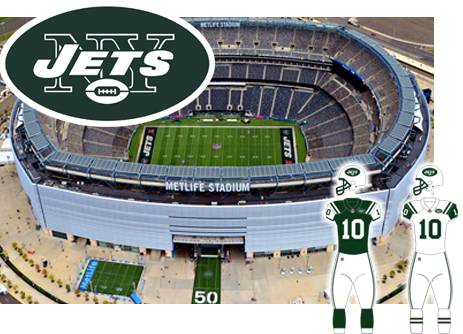
Established.... September 15, 1959
First Season.... 1960 with American Football League
Stadium..... MetLife Stadium in East Rutherford, New Jersey
Conference..... NFL East 1960-1969 / NFL 1970-present
Team Nicknames..... Gang Green
1st Game Against BUCS..... November 14, 1976
The Tampa Bay Buccaneers made their game debut against the New York Jets on Sunday, November 14, 1976 at Shea Stadium in New York, losing 00-34. Of course a game was not compleate without a John McKay take on the game:" Joe Namath is still Joe Namath, but I thought our guys were nice to him. I noticed when they knocked him down, they helped him to his feet. That was gentlemanly. I thought I saw one player standing around long enough to get his autograph."
The Buccaneers first ever victory (controveral victory) against the New York Jets came on Sunday, December 16, 1984 during a home game played in Raymond James Stadium with a paid attendance of 57,048 tickets sold, only 43,048 were in attandance to witness the victory in Tampa Bay and sadly, 13,231 fans missed seeing the last game ever for LeeRoy Selmon to play for the Tampa Bay Buccaneers.
The victory had a crazy finish as John McKay ordered the Buccaneers to let the Jets score so they could get the ball back for James Wilder and an opportunity to try and break the NFL's record for combined rushing/receiving in a season. Lost amidst the chaos, was Tampa Bays highest-ever points total (41) and Steve DeBerg throwing three TDs in a game for the first time in his Buc career.
The Jets would get their revenge the following season in the Meadowlands for coach McKays prior season Wilder fiasco with a 62 point stomping of the Buccaneers.. The Buccaneers win/loss ratio with the Jets is statistically the worst between all the franchases Tampa Bay plays.
Below click on ANY date to view extensive details of all gameday encounters. We have featured details of each opponent, highlights of each games statistics, players, scoring details, media coverage, photographs with a detailed game report. Below the listed dates we also include full details of the Opponent.
| ALL GAMES vs. JETS (H=home @=away) | |||||||||||||
| Gameday | Score | Gameday | Score | Gameday | Score | ||||||||
| @ | Nov. 17, 1976 | L | 00-34 | @ | Dec. 12, 1982 | L | 17-32 | H | Dec. 16, 1984 | W | 14-21 | ||
| @ | Nov. 17, 1985 | L | 28-62 | H | Dec. 30, 1990 | L | 14-16 | @ | Sep. 01, 1991 | L | 13-16 | ||
| @ | Dec. 14, 1997 | L | 00-31 | H | Sep. 24, 2000 | L | 17-21 | @ | Oct. 09, 2005 | L | 12-14 | ||
| H | Dec. 13, 2009 | L | 03-26 | @ | Sep. 08, 2013 | L | 17-18 | H | Nov. 12, 2017 | W | 15-10 | ||
| @ | Jan. 02, 2022 | W | 28-24 | - | - | - | - | - | - | - | - | ||
| PLAYOFF GAMES vs. JETS (H=home @=away) | |||||||||||||
| NFC Championship | Score | NFC Championship | Score | ||||||||||
The New York Jets are based in the New York metropolitan area. The Jets compete in the National Football League (NFL) as a member club of the league's American Football Conference (AFC) East division. The team is headquartered in Florham Park, New Jersey. In a unique arrangement for the league, the Jets share MetLife Stadium in East Rutherford, New Jersey with the New York Giants. The franchise is legally and corporately registered as New York Jets, LLC.
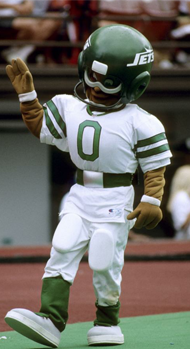
The team was founded in 1959 as the Titans of New York, an original member of the American Football League (AFL); later, the franchise joined the NFL in the AFL–NFL merger in 1970. The team began to play in 1960 at the Polo Grounds. Under new ownership, the current name was adopted in 1963 and the franchise moved to Shea Stadium in 1964 and then to the Meadowlands Sports Complex in 1984. The Jets advanced to the playoffs for the first time in 1968 and went on to compete in Super Bowl III where they defeated the Baltimore Colts, becoming the first AFL team to defeat an NFL club in an AFL–NFL World Championship Game. Since 1968, the Jets have appeared in the playoffs 13+ times, and in the AFC Championship Game four times, most recently losing to the Pittsburgh Steelers in 2010.[5] However, the Jets have never returned to the Super Bowl, making them one of three NFL teams to win their lone Super Bowl appearance, along with the New Orleans Saints and Tampa Bay Buccaneers.
The New York Jets do not have a team mascot nor do they name captains of their squads.
The Jets are one of only two teams in the NFL’s AFC division who do not have a team Mascot, the other team is the Oakland Raiders.
Rex Ryan, head coach of the Jets does not believe in team captains. His mantra of competition in all positions at all times runs contrary to naming one player of each squad a captain. The team does have a FLIGHT CREW However. A separate entity the Flight Crew is a professional dance / cheer group which makes special appearances in addition to Sunday games.
In 2013, the New York Jets added The Aviators Drumline as one of the new signature elements of the team’s gameday experience. Inspired by the energy of the New York City streets, the New York Jets Aviators are highly visible throughout gameday visiting fans in the parking lots and plaza while serving as entertainment during pregame and TV timeouts.
The team originally named the Jets Flag Crew was established in 2006. In 2007, the group underwent an expansion and was appropriately renamed the Jets Flight Crew. The squad regularly performs choreographed routines during the team's home contests. Auditions have been held annually since their inception to attract new members.
The Jets Junior Flight Crew was established in 2010 offering children the opportunity to train with the Flight Crew while improving their "talent and abilities in a non-competitive environment."
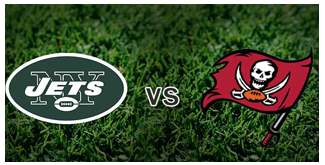
Owner Harry Wismer sought out a place for the team to play their home games but was only able to secure the dilapidated Polo Grounds, which had not had a major tenant since the baseball New York Giants vacated the stadium in 1957. The Titans played their first four seasons at the stadium—in the final season they were renamed the Jets. The Titans shared the stadium with baseball's new expansion team, the New York Mets, for two years before both teams moved to the Shea Stadium in Queens in 1964. The Jets hold the distinction of being the final team to host a game at the Polo Grounds, a 19–10 loss to the Buffalo Bills on December 14, 1963.
Wismer hoped the Titans could play in what would become known as Shea Stadium beginning in 1961.[35] However, funding difficulties and legal problems delayed construction of the stadium. Wismer signed a memorandum of understanding in late 1961 to secure the Titans' new home.[35] That memorandum recognized that the Mets would have exclusive use of the stadium until they had completed their season. As the team moved to Shea under new ownership, they were, in most years, required to open the season with several road games, a problem made worse in 1969 and 1973 when the Mets had long playoff runs.
Feeling that this arrangement put the Jets at a disadvantage, the team announced in 1977 that they would play two home games a year during the month of September at the Giants' new home in New Jersey, Giants Stadium. Litigation began between New York City and the Jets over the issue, and in the lawsuit's settlement, the city agreed to allow the Jets to play two September home games a season at Shea beginning in 1978 for the remaining six years in the Jets' lease. In 1977, the Jets were to play one September game at Giants Stadium and an October 2 game at Shea.
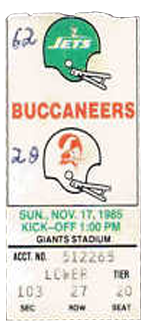
In spite of these issues, majority owner Leon Hess was interested in renewing the team's lease at Shea, which was due to expire in 1983. Hess negotiated with New York mayor Ed Koch. Hess wanted the city to redevelop the stadium to expand its capacity. He also hoped to renegotiate other aspects of the lease—the Jets received no money from ticketholders parking at Shea. Hess's proposals met resistance from Koch. When negotiations reached an impasse, the Jets announced their intention to depart for New Jersey. On December 10, 1983 the Jets played their final game at Shea and lost to the Steelers 34–7. As fans pillaged the stadium for mementos, the scoreboard read "N.J. Jets" in reference to the Jets' departure to the Meadowlands.
When the Jets joined the Giants at the stadium, many Jets fans hoped the name, Giants Stadium, would be changed. However, the Giants, who had the authority to approve the change, refused. In an effort to conceal the fact that they played in a stadium built and decorated for another team, the stadium grounds crew was assigned to make the stadium more Jet-friendly during Jets games by putting up green banners and placing the Jets' logo over the Giants'. No change could be made to the blue and red seating bowl. The Jets were featured in the first NFL playoff game in the stadium's history, falling to the Patriots on December 28, 1985.
As the Jets sought to become a stronger franchise and remove themselves from their counterparts' shadow, the team entered into negotiations with the Metropolitan Transportation Authority in an attempt to build a stadium on the west side of Manhattan, entering a bidding war with TransGas Energy Systems and Cablevision for the rights to the West Side Yard property—Hess, prior to his death, had been approached by former mayor Rudy Giuliani about bringing the team to the West Side when their lease at Giants Stadium expired in 2008. Cablevision was fixated against the Jets owning the land as Madison Square Garden, located only a few blocks away, would be forced to compete with the stadium. Team owners had voted, 31–1, with the Buffalo Bills the only objectors, to award the 2010 Super Bowl to New York contingent on the Jets winning the bid and completing construction of the stadium prior to 2010.
The MTA unanimously voted to sell the land to the Jets for approximately $210 million as the committee agreed that having the stadium would be beneficial in the long run. An angry Cablevision, community groups and transportation advocates were determined to derail the Jets' attempts at building the stadium and two lawsuits challenging the construction of the stadium on environmental grounds were filed.
Although confident they could secure the stadium, their hopes were dashed when Sheldon Silver and Joseph L. Bruno, both of whom held veto power over the stadium construction, refused to support the project, alleging it would hurt rather than help the development of the West Side.
Defeated, the Jets agreed to enter a 50–50 partnership with their rival, the Giants, to build a new stadium effectively agreeing to a 99-year lease, which the Giants had signed earlier in the year, to remain in New Jersey. The stadium, known as MetLife Stadium, became the first in the history of the NFL to be jointly built by two franchises.
|
The architects were tasked with designing a neutral stadium that would still embody the distinct personalities of both franchises. The Giants favored a traditional look of exposed steel framework and rusticated stone while the Jets wanted a sleek and modern look highlighted by metal and glass. With those features in mind the designers used the column/tower dynamic seen in many of Manhattan's skyscrapers as inspiration for the stadium's design. The base of the stadium's facade is clad in limestone-like stonework while the rest of the stadium is distinguished by an outer skin of aluminum louvers and glass and by interior lighting capable of switching colors, depending on which team is currently playing; blue for the Giants and green for the Jets. This idea originated at the Allianz Arena in Munich, Germany, which is shared between the city's two major soccer clubs, Bayern Munich and 1860 Munich. Unlike Giants Stadium, MetLife Stadium can easily be converted from a Giants game to a Jets game or vice versa, within a matter of hours. The total linear length of louvers is exactly 50,000 meters (50 kilometers) or 163,681 feet (31.1 miles). |
Embed from Getty Images |
Front row 50 yard line seats are 46 feet (14 m) away from the sideline, which is the shortest distance of all NFL stadiums. To change the field decorations, two 4-person crews take appx. 18 hours using forklifts and other machinery to remove the 40 sections of FieldTurf which make up the teams' respective endzones. Unlike most NFL stadiums, the NFL's logo is painted at midfield, instead of the logo of one of the teams, also shortening the transition time. The replaceable team logos at midfield were removed in August 2010, after Domenik Hixon tore his anterior cruciate ligament at a practice at the stadium during training camp.
Unlike a number of other new NFL venues, MetLife Stadium does not have a roof, as proposals to include a roof failed, over a dispute for funding. Thus, indoor events such as the Final Four cannot be held at the facility, which runs counter to the original aims for a new stadium in northern New Jersey.
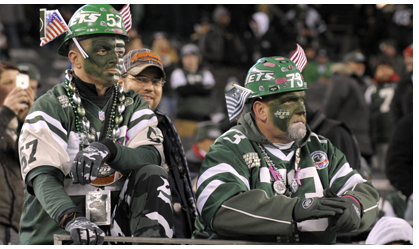
10 giant high-definition-ready light emitting diode (LED) pylons, located at the north, south, east and west entrances, display videos of the team currently in-house. The pylons measure approximately 54 feet (16 m) high by 20 feet (6.1 m) wide. Inside, are four 30 feet (9.1 m) by 116 feet (35 m) high definition video displays, and hang from each corner of the upper deck.
The new stadium seating bowl is laid out similar to that of Giants Stadium and has seating for 82,500 people, including 10,005 club seats and approximately 218 luxury suites, making it the second-largest NFL stadium in terms of total seating. The stadium, which is illuminated in different colors depending on which team is hosting a game, opened in April 2010 and saw the Jets and Giants open the stadium together in a preseason exhibition game. The Jets' first regular season home game at the new stadium was held on September 13, 2010 and was shown nationwide on Monday Night Football. New York lost to the Ravens 10–9. Team owners voted to have the stadium host Super Bowl XLVIII, held in 2014.
The first organizational meeting of the American Football League took place on August 14, 1959. Harry Wismer, representing the city of New York at the meeting, proclaimed the state was ready for another professional football team and that he was more than capable of running the daily operations.
Embed from Getty ImagesWismer was granted the charter franchise later dubbed the Titans of New York as Wismer explained, "Titans are bigger and stronger than Giants." He secured the Titans' home field at the decrepit Polo Grounds, where the team struggled financially and on the field during its first three years. By 1962, the debt continued to mount for Wismer, forcing the AFL to assume the costs of the team until season's end.
A five-man syndicate, headed by Sonny Werblin, saved the team from certain bankruptcy, purchasing the lowly Titans for $1 million. Werblin renamed the team the New York Jets since the team would play in Shea Stadium near LaGuardia Airport. The new name was intended to reflect the modern approach of his team. The Jets' owners hired Weeb Ewbank as the general manager and head coach. Ewbank and quarterback Joe Namath led the Jets to prominence in 1969, when New York defeated the heavily favored Baltimore Colts in Super Bowl III and solidified the AFL's position in the world of professional football.
When the AFL and NFL merged, the team fell into a state of mediocrity along with their star quarterback, Namath, who only had three successful post-merger seasons after injuries hampered much of his career. The Jets continued to spiral downward before enjoying a string of successes in the 1980s, which included an appearance in the 1982 AFC Championship Game, and the emergence of the popular New York Sack Exchange.
The early 1990s saw New York struggling. After firing coach Bruce Coslet, owner Leon Hess hired Pete Carroll who struggled to a 6–10 record and was promptly fired at the end of the season. Thereafter, Rich Kotite was selected to lead the team to victory; instead he led the Jets to a 4–28 record over the next two years.[16] Kotite stepped down at the end of his second season forcing the Jets to search for a new head coach.
Hess lured then-disgruntled New England Patriots head coach Bill Parcells to New York in 1997. Parcells led the team back to relevance and coached them to the AFC Championship Game in 1998. Hess died in 1999 while the team, plagued by injuries, produced an eight win record, falling short of a playoff berth. At the end of the season, Parcells stepped down as head coach deferring control to his assistant, Bill Belichick; Belichick resigned the very next day (leaving a napkin at the stage for his introduction, on which he had written "I resign as HC of the NYJ") and went on to accept the head coaching position with the Patriots.
The franchise obtained a new owner in Woody Johnson in 2000. Additionally, through the 2000s the Jets visited the playoffs five times, a franchise record, under the direction of three different coaches.[22] Rex Ryan was hired in January 2009. Ryan led the team to back-to-back AFC Championship appearances during his first two years but the team never made the playoffs again during his tenure.
Harry Wismer, a businessman, had been interested in sports for much of his life when he was granted a charter franchise in the American Football League. A three-sport letterman, football, particularly, stuck with Wismer who went on to play for the University of Florida and Michigan State before a knee injury ended his playing career. Undeterred, Wismer began his career as a broadcaster originally with Michigan State and became a pioneer of the industry. Later, as the Titans owner, Wismer formulated a league-wide policy which allowed broadcasting rights to be shared equally among the teams.
Wismer, who had previously had a 25% stake in the Washington Redskins, was interested in the American Football League and was given a franchise to develop in New York. Wismer, whose philosophy was who you knew mattered most, tried to make the team and the league a success. His efforts began to accrue debt as the Titans' first two seasons were mediocre with attendance dropping in the team's second year. The franchise was sold for $1 million to a five-man syndicate headed by Sonny Werblin of the Gotham Football Club, Inc., in February 1963.
Sonny Werblin graduated from Rutgers University and was employed by the Music Corporation of America, eventually becoming president of the company's television division. With a vast knowledge of media, Werblin was determined to put the spotlight on the team. His first order of business, after changing the team's name and jerseys, was to sign Joe Namath to an unprecedented contract. Werblin's gamble would later pay off as Namath, who became a public star, led the Jets on to victory in Super Bowl III, though by then Werblin had sold his stake in the team.
Werblin's partners, Townsend B. Martin, Leon Hess, Donald C. Lillis, and Philip H. Iselin, had a falling out with Werblin over the way the team was run—though the franchise had begun to make a profit, Werblin was making all the policies and decisions himself with little or no input from his partners, much to their dismay. Though Werblin initially resisted their ultimatum to dissolve the partnership, Werblin agreed to be bought out in 1968. Werblin remained involved in the sports community and became the first chairman and CEO of the New Jersey Sports and Exposition Authority where he helped to create the Meadowlands Sports Complex, including Giants Stadium.
Hess became well known for his Hess Corporation gas stations; however, he also played an instrumental part in the development of the Jets during his tenure as co-owner and eventual sole owner. Hess had often fought for improvements while the team was a tenant at Shea Stadium but generally stayed away from football operations, allowing his coaches and general manager to make football-related decisions.
Becoming the team's majority stockholder in 1973, Hess bought Philip H. Iselin's share upon his death in 1976 after which only two of Hess' partners remained, Townsend Martin and Helen Dillon, who had inherited the stake from her father Donald Lillis, upon his death. Hess began to buy out the remaining partners in 1981 when he bought Martin's 25% stake for $5 million. Hess bought Dillon's stake three years later for another $5 million, acquiring sole control of the team.
Hess had a passion for his team and took losses hard. In 1995, following a mediocre 6–10 season under Pete Carroll, despite generally shying away from football operations, Hess announced "I'm 80 years old, I want results now" during a conference in which Rich Kotite was introduced as the team's new coach. After two unsuccessful years with Kotite, Hess heavily involved himself in hiring Bill Parcells in hopes to see his team again reach the Super Bowl. He did not live to see his dream realized, dying on May 7, 1999.
With the team for sale, two potential buyers were found in Cablevision and philanthropist Woody Johnson whose grandfather, Robert Wood Johnson II, expanded Johnson & Johnson. Johnson was unknown among the other NFL owners at the time of his $635 million purchase of the franchise. However, Johnson had a passion for sports according to former Knicks general manager Ernie Grunfeld and desired to own his own team. Johnson has been considered to be an enabler who wants the best from his employees.
Much like Hess, Johnson left many of the football related decisions up to his management team and tended to avoid the spotlight. However, upon hiring head coach Rex Ryan, Johnson had an increased presence as he molded the Jets into his team.
The New York Jets' colors are hunter green and white. The team's current uniform and primary logo, in use since 1998, are modernized versions of the design used from 1965-77. The helmet is white with two parallel green stripes down the center, and a green facemask. The primary logo, which appears on each side of the helmet and on the jersey front by the player's left shoulder, is a green oval with the word "JETS" in thick white sans-serif italics over "NY" in outline serif lettering, and a white miniature football graphic at bottom center. The jerseys have standard one-color block numerals and serif lettering, alternating stripes on the shoulders, and opposite-colored sleeves and TV numerals. The team uses both white pants with two parallel green stripes from hip to knee on each side, and green pants with white stripes.
The team's original uniforms, as the Titans of New York in 1960, were navy blue with old gold numerals, gold pants with two parallel blue stripes on each side, and navy blue helmets with a single gold stripe down the center and no logo decals. The white jerseys had navy blue numerals. In 1961, the Titans added UCLA-style shoulder stripes (gold and white on the blue jerseys, gold and navy blue on the white jerseys), changed the pants striping to a blue stripe flanked by white stripes, and employed a somewhat brighter shade of gold.
When the Titans became the Jets in 1963, navy and gold were abandoned in favor of kelly green and white. The jerseys had opposite-colored sleeves with thick stripes on the shoulders and cuffs, above and below the TV numerals. The pants were white with two parallel green stripes on each side. The new helmets were white with a single green stripe down the center; the logo on each side was a silhouette of a jet airplane in green, with the word "JETS" in thick white sans-serif italics along the fuselage. In 1964, the single green stripe became two parallel stripes, and the jet-plane decal was replaced with a white football shape outlined in green, with the word "JETS" in thick green sans-serif italics in front of "NY" in green outline serif lettering, and a miniature football at bottom center. The decals were difficult to see from a distance (or on television), so the colors were reversed in 1965.
This design remained largely unchanged through 1977, apart from some variations to the numeral and lettering typefaces, the angle of the helmet decals, and adjustments to the shoulder and sleeve striping due to changes in NFL jersey tailoring and materials.
The Jets' first major design change was made for the 1978 season. The kelly green and white color scheme was retained; the new helmets were solid green with white facemasks, and a stylized "JETS" wordmark in white on each side. The mark featured angular lettering and a silhouette of a modern jet airplane extending horizontally to the right from the top of the "J" above the "ETS". The jerseys featured large TV numerals on the shoulders and two thick parallel stripes on the sleeves, while the pants had a single green stripe from hip to knee on each side. In 1990, the Jets modified this design by adding thin black outlines to the numerals, lettering, stripes and helmet decals, changing the facemasks from white to black, and adding a set of green pants to be worn with the white jerseys.
The Jets adopted their current uniform and logo design in 1998. Green pants were added in 2002, and have been worn with both the white and green jerseys.
The Jets were the first NFL team to wear a "throwback" uniform, in 1993 for a home game against the Cincinnati Bengals celebrating the 25th anniversary of the 1968 championship team. The jersey and pants mimicked the 1963–77 design, although the team wore its regular green helmets with a white-outlined version of the 1965–77 logo decal. In 1994, as part of the NFL's 75th Anniversary celebration, the Jets wore both home and road versions of this uniform in select games, again using their regular green helmets with the 1965–77 logo but with two parallel white stripes down the center.
In 2007, the team introduced a new "throwback" uniform, evoking the original Titans of New York and combining elements of the 1960 and 1961–62 uniforms, with navy blue helmets and jerseys, old gold numerals and helmet stripes, gold and white shoulder stripes, and gold pants with blue and white stripes on each side. These uniforms appeared again in 2008, 2009 and 2011, with a white jersey variation also appearing in 2009 as part of the NFL's celebration of the American Football League's 50th anniversary.
Ewbank, Martin, Maynard, and Namath are recognized based upon their achievements with the Jets. Ewbank is also recognized based upon his achievements with the Baltimore Colts, coaching them to NFL championships in 1958 and 1959. Riggins is recognized primarily for his seasons with the Washington Redskins (1976–1979, 1981–1985), as is Monk (1980–1993), who won three Super Bowl championships with Washington. Lott is in the Hall of Fame primarily for his exploits as a member of the San Francisco 49ers. Baugh and Turner are recognized based upon their achievements as players with other teams, rather than their head coaching stints with the Jets. While Parcells reversed the fortunes of the Jets, he had major impact for the New York Giants, coaching them to two Super Bowl victories. Wolf only had a brief stint with the Jets between 1990 and 1991, while most of his major contributions occurred as an executive and player personnel director with the Oakland Raiders (1963–1974, 1979–1989), and later as General Manager of the Green Bay Packers (1991–2001). Favre only played one season as a member of the Jets in 2008, between most of his career with the Packers (1992–2007) and his last two NFL seasons with the Minnesota Vikings (2009–2010).
Copyright 2002-2025. © BuccaneersFan.com | © Ye Krew of Pewter | © #BUCMOBILE All Rights Reserved. 2025 W.P. Rader aka Professor Jam